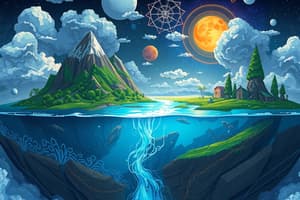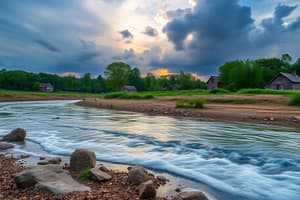Podcast
Questions and Answers
Weather is the atmospheric condition for a long period of time, such as a month.
Weather is the atmospheric condition for a long period of time, such as a month.
False (B)
Climate represents the average weather conditions over a short period of time.
Climate represents the average weather conditions over a short period of time.
False (B)
The water cycle involves the continuous movement of water between the Earth's surface and the atmosphere.
The water cycle involves the continuous movement of water between the Earth's surface and the atmosphere.
True (A)
Different weather conditions like rain, snow, and storms are caused by the stationary movement of water.
Different weather conditions like rain, snow, and storms are caused by the stationary movement of water.
Climate refers to the atmospheric conditions in a specific place for a short period of time, such as a week.
Climate refers to the atmospheric conditions in a specific place for a short period of time, such as a week.
During the water cycle, collection is the first step before evaporation.
During the water cycle, collection is the first step before evaporation.
In the water cycle, precipitation occurs before condensation.
In the water cycle, precipitation occurs before condensation.
The Sun heats water so it condenses, then it evaporates to start the water cycle.
The Sun heats water so it condenses, then it evaporates to start the water cycle.
Evaporation is the last step in the water cycle.
Evaporation is the last step in the water cycle.
Runoff involves the water moving through plants and animals in the ecosystem.
Runoff involves the water moving through plants and animals in the ecosystem.




